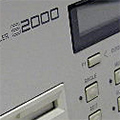IN USE
After waiting 30 seconds or so for the operating system to load in from floppy, I found the S2000 as easy to use as most other Akai samplers, and there’s little new to learn other than the introduction of a new ‘Multi’ mode of operation which brings the S2000 more into line with its contemporaries. On older Akai machines, multitimbral operation was achieved by loading several programs, all with the same program number, then allocating these to different MIDI channels, which often involved a degree of tedious renumbering and channel changing. You can still work this way in Single mode, which is an obvious advantage if you have existing library material in the old format, but in Multi mode, you can slot in any 16 programs, regardless of their program numbers. This has the advantage that if you want to call up a new program part way through a mix, you can do it using a program change, just as you would with a multitimbral synth. You can also change the pan positions of programs within a Multi; these override the pan settings of the original programs. Perhaps the biggest creative value of Multi mode is that you can make adjustments to things like envelope settings in context — for example, while a sequence is running, or when two or more sampled sounds are being used as layers.
The manual admits that there is a bug in this current software version which prevents you from saving Multis properly, so you have to save the whole memory, including any samples you have loaded that are not included in the current Multi. I suppose this could cause difficulties if you are short of storage space, but I didn’t find it a huge problem, and Akai do promise that it should be fixed by the next software revision.
Creating your own samples from scratch is quite easy, though I did have problems watching the display at the same time as trying to play a sustained digeridoo note! A bargraph creeps across the screen as sampling takes place, so you can see at a glance how much longer you need to blow, twang or hit. I found that looping the digeridoo sample was quite easy, and once I’d picked a reasonable ball-park loop point, the Find command improved upon it. A crossfade loop completed the job, but it was here I discovered an immense irritation, namely that once you’ve done a crossfade, you can’t undo it — you have to reload the sample and try again. I mentioned this to Akai, who say that the existing hardware can’t cope with undoes, so don’t expect miracles in the next software upgrade — of the available options, loaves and fishes are not included!
I finished off by making some more samples, tuning them, and slotting them into keygroups. I then saved the whole shooting match to disk, just to prove that it would load up properly. It did.
The only real operational frustration was the slowness of CD-ROM access, which is compounded by the uncertain nature of the data entry wheel. It appears that instead of the S2000 loading up the entire list of contents from the disk (which would let you see at a glance what was available), it looks for the items on disk one at a time, so if you turn the wheel too far, you can end up several items past the one you’re looking for before the display registers the change. Akai are now aware of this, and will see what can be done in the next software upgrade. The other thing the S2000 can’t do is create Multis that will automatically load in the appropriate sounds from CD-ROM for you — this would make life much easier, and surely shouldn’t be too much of a challenge for today’s technology.
ANOTHER FINE MESA?
Bundled with the S2000 and S3000 is a software package called MESA. It provides a more visual means of organising samples into keygroups and sorting out envelopes and filter settings, as well as zones, modulation, pan and so on. MESA also allows you to load AIFF or Sound Designer II files for use as samples, and a zoomable graphic waveform display helps you find the best sample loop points. Sadly, MESA doesn’t let you do your crossfade looping on the computer, and you can’t splice bits together from different samples or even remove a chunk from the middle of an existing sample
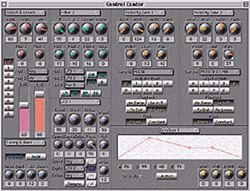
Overall, MESA is probably far too powerful in areas you’re never likely to need, and noticeably underpowered in the sample editing department, though its graphics are attractive and fairly clear. The operating system is more than a touch cryptic, and though the on-line help does a reasonable job of guiding you through it, my initial impression was that it made about as much sense as Morris dancing!
Initially, I expected to see a nice friendly box saying ‘load sample from sampler’, but no, that’s too easy. Instead, you have to open something called the Toolbox, which shows you a postage stamp-sized picture of a computer and a sampler. You then have to interrogate the sampler to get a list of samples and programs up on the screen. Then (and this is the good bit) you have to open the sample edit window, go back to the sample list window, grab the sample you want to work on, drag it to a letter box icon on the sample edit page, and post it!
Once you’ve done this, the sample finally comes up in the computer window. It’s rather like finding your way around one of those mindless adventure games where you come across a sheer brick wall, only to be told that you can’t go any further because your troll isn’t carrying the right type of fish to trade in for a magic anti-gravity belt! When you finally do sort out your loop points, you have to post the result back into the original sample list to send it back to the sampler before you can deal with any crossfading. What’s more, I couldn’t find any means of using my MIDI keyboard via the computer to check out the results of my editing. There is a floating window containing play and stop controls which lets you hear the sample at its original pitch, but you really need to know how things sound at different pitches, or when played as chords.
During my tour of MESA, I found countless references to something called ‘scripting’, and on trying to open some of the scripts provided, I was told that I needed AppleScript. At first, I wondered whether this might be some form of elven calligraphy performed on fruit that needs to be picked up earlier in the game! However, it turned out to be an extension (pre-installed on all System 7.5 Macs, but also available separately to Macs with earlier system versions) which allows you to automate tasks you perform regularly. However, I saw little point in being able to construct my own faders and buttons (which is part of what ‘scripting’ is all about) when what I really wanted was for the program to be a damn sight simpler and to help me sort out my crossfades. At this point, I sheathed my magic sword and headed for home.
If you have access to AIFF or SDII files, then MESA will be useful in transferring these to your sampler, and I’m sure the program creation features will be wonderful when you finally get used to them, but if you want to do serious sample editing, then you still need a dedicated program to do the job for you. In MESA‘s favour, because samples are transferred back and forth using SCSI rather than MIDI, the sound you’re working on is still likely to be in fashion by the time you get it loaded. Transferring samples via MIDI is about as slow as trying to back up a digital recording by writing the 1s and 0s on a sheet of paper by hand!
SUMMARY
Even taking into account my minor criticisms, such as the rather non-tactile data wheel and the inscrutability of the bundled MESA software, the S2000 is sensationally good value. As a straightforward sampler, it’s easy to use, sounds exceptionally good, and its SCSI interface provides direct access to a huge range of existing library material on CD-ROM.
Even if you go for all the options, which will more than double the price of the basic unit, you still have a very cost-effective sampler. The only real limitations are in the sample editing department, where you’re restricted to a single loop, and can’t graft different bits of different (or even the same) samples together. The use of SIMMs makes it far more cost-effective to add more memory (though I don’t know why 8Mb SIMMs are taboo), and being able to add outputs, effects or filters when you can afford them is a good way to spread the cost of buying a really first-rate machine.
Existing S3000 owners (especially those who use multiple machines in live performance) can use the S2000 as a very cost-effective expander module, where two samplers can share a single hard drive. This has the obvious advantage that editing can be done in the slightly more friendly S3000 environment.
I suppose the ultimate question is, would I buy one? The answer is that I’ve just sold my S950, and decided to reinvest the money in an S2000. It’s not quite perfect — but it’s as perfect as you get for the price! Now all I need to do is find the enchanted chalice of Ethelrond and the mighty sword of Grothrud that allows my troll to activate MESA‘s MIDI interface — if it has one!
BACKWARDS COMPATIBILITY
I tried loading my old Akai S950 samples from floppies, and though these took a short while to convert, they survived the trip with no problems. However, I had less success when I tried to read my old S950 Syquest disk; the S2000 refused to talk to it. Akai revealed that this is because S950 disk directory structures are so different from the ones on all their samplers from the S1000 onwards. For the same reason, an upgrade to correct this is unlikely, which means that all transfer of S950 samples will have to be done via floppy disk… groan!
EXPANSION OPTIONS
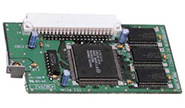 EB16 MULTI-EFFECTS PROCESSOR
EB16 MULTI-EFFECTS PROCESSOR
This is a 4-channel processor which can handle two channels of basic reverb and two channels of simultaneous multi-effects. The effects available include distortion, 3-band EQ, ring modulation, modulated delays effects (chorus, flange and so on), pitch-shifting, rotary speaker effects, stereo delay and reverb.
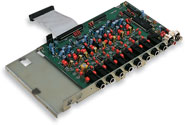 • IB208P ASSIGNABLE OUTPUTS
• IB208P ASSIGNABLE OUTPUTS
The existing stereo output can be supplemented by eight assignable outputs if you fit the IB208P expander option, which also includes digital I/O on phono connectors. Samples can be loaded directly from CD or DAT machines with S/PDIF compatibility, but working with sample rates of 48kHz is not recommended.
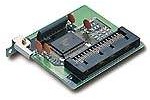 • IB304F FILTER BANK
• IB304F FILTER BANK
The internal 12dB/octave, low-pass filters may be augmented by an optional second bank comprising high-pass, low-pass, band-pass and EQ filter modes. An additional envelope generator is included as part of this option.
• MORE MEMORY
Memory is expandable using standard computer SIMM chips (2, 4 or 16Mb SIMMs only), to a maximum of 32Mb, which translates to almost six minutes of mono sampling time at 44.1kHz, or three minutes of stereo. There are two SIMM slots, and you aren’t restricted to using two SIMMs at once or SIMMs of the same capacity. If the the full 32Mb is fitted, the 2Mb of on-board RAM cannot be used.
Akai kindly provided an extra memory SIMM, and this gave me an excuse to take the lid off the machine. Nearly everything is one large circuit board, and the SIMMs slots are easily accessible. SIMMs will only fit into their sockets the right way round, so there’s no problem with accidentally reversing them, though you do have to take precautions against static electricity. Removing the lid is a simple matter of taking out five crosshead screws, and the whole procedure takes less than five minutes.
• EXTRA STORAGE
Though there is no provision for an internal hard drive, the standard SCSI interface means that any SCSI hard drive, Syquest, magneto-optical or similar drive system may be used to store sample, program and multi data. The architecture of the S2000 can only address 500Mb per hard drive, though more than one SCSI drive may be used.
Once formatted, a hard drive may be partitioned. Each partition can contain up to 128 volumes, and each volume (which can be thought of as being similar to an Atari ST or Mac folder), can hold up to 510 items, which may be programs, samples, multis or effects settings. According to Akai, Iomega’s new low-cost Zip drives have been checked out with the S2000 and work fine.
Two internal Flash RAM card slots are provided so that frequently used programs can be held in memory, even when the power is off. This leaves the conventional RAM memory free to be used as normal.
‘AND… STRETCH!‘
Those interested in the Timestretch function may be pleased to know that it’s exactly the same system as used in Akai’s S3000. This means you can change a sample’s length by up to five or six percent without altering the pitch before the sound quality starts to suffer too much. There are various settings for different types of material, and what works for drums won’t produce the best results with a sustained tone. Some experimentation is in order, and because the process isn’t all that fast, expect to spend some time working with it before you get the best possible result. If you need to do a lot of pitch or time changing, or if you want a greater range than Timestretch can provide, the only truly satisfactory option is to use a dedicated hard disk editing system in conjunction with a program such as Steinberg’s Time Bandit.
Review appeared orginally in Sound on Sound magazine
